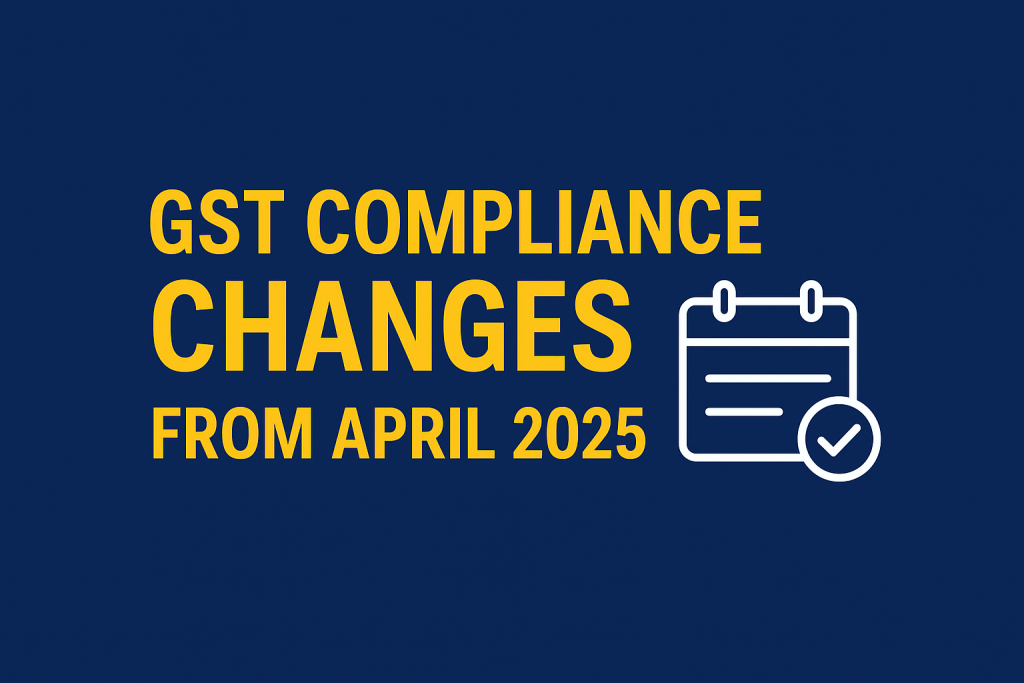GST Compliance Changes from April 2025: What Your Business Needs to Know

From April 1, 2025, significant changes to India’s Goods and Services Tax (GST) regime will come into force. These updates—including mandatory Multi-Factor Authentication (MFA) for taxpayer logins and revised e-way bill rules—are designed to strengthen compliance, curb fraud, and digitise supply chain transparency. For GST-registered businesses of all sizes, understanding and implementing these changes isn’t optional—it’s mandatory. This blog provides a comprehensive, step-by-step guide covering implementation timelines, compliance workflows, cost implications (all figures in INR), and an impact assessment to help your organisation seamlessly adapt.
Why These GST Changes Matter Now
- Combatting Fraud and Error: With annual GST collections crossing ₹18 lakh crore, the government is doubling down on digital authentication to prevent fake invoices and irregular refunds.
- Enhancing Supply Chain Visibility: Updated e-way bill restrictions will streamline transport-related verifications, reducing transit delays and disputes.
- Global Best Practice Alignment: MFA adoption aligns India’s digital tax framework with leading jurisdictions like the EU and Australia.
Key Changes Effective April 2025
Mandatory Multi-Factor Authentication (MFA)
- What’s New: All GST portal user accounts (principal and additional) must be secured with MFA.
- Approved Methods:
- Mobile OTP via registered number
- Authenticator apps (e.g., Google Authenticator, Microsoft Authenticator)
- Hardware tokens (for high-value taxpayers only)
- Effective Date: April 1, 2025
- Cost Estimate:
- Authenticator apps: Free
- Hardware tokens: ₹500–₹1,200 per device
- SMS OTP charges: ₹0.50 per OTP
Revised E-Way Bill Restrictions
- Threshold Changes:
- Inter-state and intra-state consignments above ₹50,000 now require a pre-generated e-way bill.
- Validation Points:
- Mandatory geotagging for vehicles at origin and destination
- Mandatory QR code scanning at checkpoints
- Effective Date: April 1, 2025
- Estimated Compliance Cost:
- GPS device installation: ₹2,000–₹3,500 per vehicle
- Software subscription: ₹5,000–₹15,000 per annum for e-way bill management systems
Enhanced Late-Fee Structure
- Revised Fees:
- For returns filed after the due date, fees increase from ₹100/day to ₹200/day (capped at ₹10,000 per return).
- Effective Date: April 1, 2025
Step-by-Step Compliance Guide
- Assess Current Systems (January–March 2025)
- Audit all GST portal users and login methods.
- Identify vehicles and routes impacted by e-way bill updates.
- Plan MFA Roll-Out (February 2025)
- Select MFA methods suited to user roles (e.g., hardware tokens for CFO, authenticator apps for accountants).
- Budget for hardware tokens, SMS charges, or mobile app roll-out.
- Update Software & Infrastructure (March 2025)
- Integrate MFA SDKs into your ERP or GST filing software.
- Configure e-way bill management tools with geotagging and QR scanning modules.
- User Training & Onboarding (March 2025)
- Conduct webinars and hands-on sessions for your finance and logistics teams.
- Distribute user guides on MFA setup and e-way bill creation workflows.
- Dry Run & Validation (Last Week of March 2025)
- Simulate login flows with MFA.
- Generate test e-way bills for various consignment values and routes.
- Go-Live & Monitoring (From April 1, 2025)
- Enforce MFA for all GST portal logins.
- Track real-time compliance metrics: OTP success rates, e-way bill rejection incidents.
- Review exceptions and resolve errors within 48 hours.
Implementation Timeline
| Milestone | Timeline |
| GST User Access Audit | Jan 1–Feb 15, 2025 |
| MFA Method Selection & Budgeting | Feb 10–Feb 28, 2025 |
| Software & Token Procurement | Mar 1–Mar 15, 2025 |
| User Training Sessions | Mar 16–Mar 25, 2025 |
| Dry Run & Issue Resolution | Mar 26–Mar 31, 2025 |
| Full Compliance Enforcement | Apr 1, 2025 onwards |
Business Impact Assessment
Operational Impact
- Finance Team: Increased login security may add 10–15 seconds per authentication; plan extra time during peak filing periods.
- Logistics Team: Geotagging and QR scanning could increase checkpoint dwell time by 2–3 minutes per stop.
Financial Impact
- One-Time Costs:
- Hardware tokens for 10 users: ₹12,000 (10×₹1,200)
- GPS devices for 20 vehicles: ₹60,000 (20×₹3,000)
- Recurring Costs:
- SMS OTP: ₹1,000/month (assuming 2,000 OTPs)
- E-way bill software: ₹10,000/year
Compliance Risk Mitigation
- Penalty Avoidance: Upgraded late-fee structure could cost up to ₹10,000 per delayed return—effective MFA and e-way bill controls reduce filing errors and transit violations.
- Audit Readiness: Detailed logs of MFA access and e-way bill scans provide robust evidence in case of GST audits.
Best Practices for Smooth Transition
- Centralised Monitoring Dashboard: Use a unified portal to track OTP delivery rates, login failures, e-way bill creations, and rejections in real time.
- Escalation Protocols: Define clear escalation workflows for OTP failures or geotag mismatches to minimise downtimes.
- Continuous Review: Conduct monthly compliance audits to identify process bottlenecks and refine protocols.
Frequently Asked Questions
Q1: What happens if a user fails MFA?
If OTPs aren’t delivered within three attempts, the account locks for 30 minutes. Implement backup methods (hardware token or authenticator app) to ensure uninterrupted access.
Q2: Are there exemptions for small businesses?
No. All GST-registered entities, regardless of turnover or size, must comply with MFA and e-way bill updates from April 2025.
Q3: Can e-way bills be amended after generation?
Yes, amendments are allowed within 24 hours for correct values and route adjustments. Late amendments incur an additional fee of ₹100.
Conclusion
The GST compliance changes effective April 2025 mark a pivotal shift towards enhanced digital security and supply chain transparency. While the initial implementation requires investment in tokens, devices, and software, the benefits—reduced fraud, smoother audits, and more reliable logistics—far outweigh the costs. By following the step-by-step guide, adhering to the timeline, and leveraging best practices, businesses can achieve seamless compliance and safeguard themselves against penalties. Prepare now to ensure a smooth transition on April 1, 2025.



